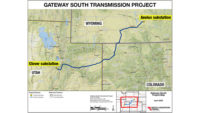It was an imposing task: to connect the remote but windy areas of Texas to the state's power grid with modern, efficient transmission lines that would carry needed wind energy to population centers.
The Texas Legislature took on the task in 2005, passing a law establishing the state's competitive renewable energy zones (CREZ). Seven years later, a dozen companies and hundreds of contractors and subcontractors are close to finishing the work.
When complete next year, the $6.95-billion CREZ project will have 3,500 miles of new 345-kV transmission lines that will move up to 18,500 MW of wind power across the state. However, preliminary system engineering, which used straight-line planning, greatly underestimated the number of miles of line needed to avoid towns and environmentally sensitive areas. The final product includes almost 1,000 additional miles of lines than originally anticipated, which has increased costs by $2 billion.
In addition to providing a way for new wind power to get to the markets, the system additions will ease congestion on existing transmission lines and allow conventional power facilities, such as natural gas plants, to be built in the western half of the state, possibly helping to ease an expected shortage of electricity after several coal plants are shuttered.
Paving the way for power
"It's like the interstate highway system," says Wes Speed, vice president of transmission for Oncor Electric Delivery, a division of Dallas-based Energy Future Holdings Corp., which has the largest chunk of the project that originally was valued at about $2 billion. Like the interstate highway system, CREZ will have many unexpected benefits, such as opening up the region to conventional powerplants, he says. Despite the increase in cost, the system's benefits are still expected to outweigh its costs, says Catherine Cuellar, a spokeswoman for Oncor.
After the Legislature adopted the CREZ concept in 2005, the Electric Reliability Council of Texas analyzed what transmission lines were needed. In 2009, the Texas Public Utility Commission divided the project into about 14 slices and awarded them to transmission providers in and out of the state.
In addition to Oncor, the commission awarded contracts, in descending order of size, to various utilities and transmission providers. They include Electric Transmission Texas (ETT), a joint venture of American Electric Power Co. Inc., Columbus, Ohio, and Mid-American Energy Holdings, Des Moines, Iowa; Lower Colorado River Authority, Austin, Texas; Lone Star Transmission, a subsidiary of Jacksonville, Fla.-based FPL Energy LLC; Sharyland Utilities LP, McAllen, Texas; Cross Texas Transmission LLC, a division of New York City-based LS Power Group; and five other companies that received smaller projects.
While many of the substations have been completed, much of the transmission line has not been finished. Approval of rights of way has slowed the effort down. But all providers expect to have their projects completed by the end of 2013.
Waiting in the Wings







